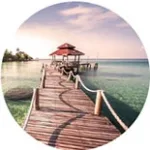
When paying with Chinese money, have you ever noticed that the banknotes show pictures of some of the most beautiful highlights from all over China? Chances are, you didn’t.
Money forms a big part of the everyday lives of the Chinese. They carry these small, pocket-sized images of The Great Hall of the People, the Li River, and the Qutang Gorge with them wherever they go.
Besides the breathtaking images on the banknotes, there’s probably more you don’t know about China’s official currency, the Chinese Renminbi. That’s why we came up with this practical guide to using Chinese money.
Your guide to using Chinese money
One currency with many names
There are many different names for Chinese money, varying from Renminbi (RMB) to Yuan (CNY), and Kuai. The official name of the Chinese currency is Renminbi, and the Yuan, also used as the name for the Chinese currency, is its basic unit. The Renminbi is issued and controlled by the People’s Bank of China.
The word Kuai is the colloquial designation of the Yuan and means piece. Sometimes the Chinese use the word Kuai for the Hong Kong Dollar or US Dollar too.
Currently, Chinese money consists of banknotes of 1, 5, 10, 20, 50, and 100 Yuan, banknotes of 1 and 5 Jiao (10 Jiao is equal to 1 Yuan), as well as 1 Yuan coins, and 1 and 5 Jiao coins.
For the current exchange rate of the Chinese Yuan against the US Dollar, visit the Bank of China website.
Obtaining Chinese money
When traveling in China, keep in mind foreign currencies aren’t accepted, with the exception of the occasional souvenir shop. So if you want to be well-prepared, it’s a good idea to bring some Chinese money with you for your tour.
You can bring up to 20,000 RMB (or foreign currencies in cash worth Not more than $5000 USD) with you to China, without having to declare at customs. However, if you’re planning on bringing more Chinese money into the country, declaring is a must. At the end of the tour, you can exchange your Chinese Renminbi back to your own currency, or keep the remaining local money as a souvenir. The same rules regarding declaration apply when you leave the country as well.
In general, bringing large amounts of Chinese money with you to China isn’t necessary. There are plenty of currency exchange services available. You’ll find them at most international airports, 4 and 5-star hotels, and central business areas in the cities. Remember to keep your passport handy as you’ll need it for any currency exchange transaction.
Payment options in China
In addition to using Chinese money, major credit cards, such as Visa, MasterCard, Diners Club, AMEX, and JCB card of Japan are widely accepted in China’s major cities, as are ATMs. Like most big cities, ATMs are everywhere – inside banks, on street corners, in hotels, shopping malls, subway stations, post offices, and many more locations. Just look for the VISA, MasterCard, AMEX logos on the ATM, and you’re good to go.
Keep in mind most ATMs have a daily maximum withdrawal amount, which is usually 20,000 RMB. The maximum amount per transaction is 3000 RMB, or less, depending on the ATM you are using.
Travelers’ cheques are quite common in China, but you do need to cash them first. Purchasing and cashing a travelers’ cheque is fairly easy, and can be done in most major Chinese banks.
Please note that in small towns, cash is usually the only way to pay. Make sure you bring a sufficient amount of Chinese money with you when traveling to remote areas.
Hong Kong, Macao, and Taiwan money
The Chinese Renminbi is broadly accepted in Hong Kong and Macao, although swapping them for Hong Kong Dollars or Macanese Pataca is simple, and can be done on virtually every street corner.
It’s a little different for Taiwan, where the Renminbi will not be accepted. However, many banks, hotels, and department stores in Taiwan allow you to exchange major currencies into New Taiwan Dollars.
How to spot not so real Chinese money (how to spot a fake)
China has quite a counterfeit currency problem. From the convenience store where you buy a drink, to the taxi ride to town, and the restaurant you went for dinner, all may operate with a mix of real and fake Chinese money.
Even when you’re withdrawing money from an ATM at a major bank, receiving fake notes is rare, but not uncommon, so pay attention when receiving any larger amounts banknotes. Here’s what to look out for:
- Ruffle the banknote in your hand (try not to crumple it), and listen carefully. Real banknotes should make a clear and distinct cracking noise, whereas fake ones sound a bit muffled.
- The watermark on an authentic banknote is fairly distinct. The 5, 10, and 20 Yuan notes each has its own distinct floral design, while the 50, and 100 Yuan notes show the face of Chairman Mao. When holding up the note towards the light, you should see a clear image, while on fake ones, the images aren’t that clear.
- On the right side of all banknotes, there’s another illustration of Chairman Mao. Gently rub your thumb against the collar of the picture. On a real note, the texture should feel a bit rough, and slightly raised from the paper as opposed to a smooth fake note. The same goes for the name ‘zhongguo renmin yinhang’.
- Near the picture of Chairman Mao, on the top right corner, and below the monetary value, there’s a secondary translucent value just below. You can only see this secondary value when you hold the note at a 180 degrees angle towards the light. Some fake notes may have this as well, however, it won’t be as clear as on a real note.
- There’s a metallic-looking security line interwoven in the middle of an authentic note. On a fake note, this security line is not interwoven, but rather just sits on the note instead.
- Other ways to check are mismatches between some of the patterns on each side, irregular gaps between the digits that make up the serial number and checking for the colorless fluorescent value at the top of a note under ultraviolet light (this won’t appear as clear on a fake note).
The six exotic sites of Chinese banknotes
Tourism is becoming an important driving force in China’s economic growth. Perhaps, that’s why some of China’s tourist attractions are featured on the reverse side of six of its banknotes.
Consider it an itinerary that will take you to six of China’s exotic and breathtaking sites.

On the 100 Yuan note, you will find The Great Hall of the People, located in Beijing. This imposing structure is the meeting venue of the National People’s Congress and the Chinese Parliament. It is considered the political center of China. Its main highlight is the red star on the ceiling and the surrounding patterns of blue waves representing the Chinese people.

The reverse side of the 50 Yuan note shows a must-visit sight to be experienced on a Tibet tour, the Potala Palace in Lhasa. Once the spiritual center in Tibet and residence of the Dalai Lama, today, the palace is used as a museum. With over 1000 rooms and various statues, tombs, and antiques to admire, it’s easy to catch a glimpse of life inside these walls more than half a century ago.

The picturesque Li River is shown on the back of the 20 Yuan note, a landscape characterized by tall limestone mountains, luscious rice fields, bamboo groves, and buffaloes. A boat trip on the Li River is perfect for soaking in the beautiful surroundings of Guilin and is often included in tours of Guilin.

No cruise along the Yangtze River is complete, without passing the Three Gorges. Featured on the reverse side of the 10 Yuan note, is the Qutang Gorge. Even though it’s the shortest of the three, it’s also considered the most spectacular one. The imposing mountains on either side of the narrow river make for a breathtaking view.

On the reverse side of the 5 Yuan note, the Mount Tai stands tall (1545 meters, to be exact). It’s one of five sacred mountains in mainland China and has been an important place of worship for the last 3000 years. Mount Tai offers spectacular views of its surroundings and has been on the UNESCO World Heritage list since 1987.

The most famous and beautiful West Lake in the world, according to Lonely Planet. No wonder it’s shown on the reverse side of the 1 Yuan note. West Lake truly makes Hangzhou a memorable travel destination. The West Lake inspired many gardeners, poets, and painters with its scenic natural beauty. The most iconic view of the West Lake is the three man-made islands, called “Three Ponds Mirroring the Moon” West Lake was recognized as a UNESCO World Heritage Site in 2011.
Tour China with ChinaTours.com
Inspired by these six fascinating and diverse sites? Why not talk to our China tour experts and book your unique China experience today. Maybe have a look at our wide range of China Panda tours, or visit our Best China Tours page.
Wondering which cities to visit on your upcoming China tour? Don’t let confusion and overwhelm stop you from planning and designing a China tour that makes for beautiful travel memories. With over a decade of experience at creating tours to twenty unique and interesting cities in China, we can help you finally cross those must see destinations and sights off your bucket list. Let’s get you organized and on the road to a real experience of China. Have a look at some of our most popular China Tour packages now…




 Beautiful China!
Beautiful China!





